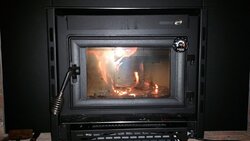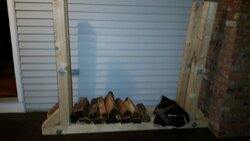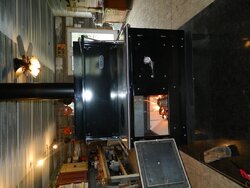We will hopefully be ready to fire the Kitchen Queen 480 this weekend for the first time. We have never had a wood burner and are wondering what to expect with first burn. Planned on doing just a few very small fires to start with. Will it smoke a little until creosote builds in gaps? Will it smell from new chimney? What should wew look for? Thanks!
What to expect with first burn??
- Thread starter Bubbas Boys
- Start date
-
Active since 1995, Hearth.com is THE place on the internet for free information and advice about wood stoves, pellet stoves and other energy saving equipment.
We strive to provide opinions, articles, discussions and history related to Hearth Products and in a more general sense, energy issues.
We promote the EFFICIENT, RESPONSIBLE, CLEAN and SAFE use of all fuels, whether renewable or fossil.
You are using an out of date browser. It may not display this or other websites correctly.
You should upgrade or use an alternative browser.
You should upgrade or use an alternative browser.
- Status
- Not open for further replies.
You will get some smell from the pain curing possibly even a little smoke if you have good draft there should be no smoke from the fire the entire venting system and stove should be under vacume so it will suck air into any gaps. And no the gaps should not fill up with creosote.
Chimney Smoke
Minister of Fire
Follow the owners manual for break in fires. You will likely do a few small fires just to settle things in but then you're going to want a good hot fire to cure the paint and burn off any assembly oils and grease. I was glad it was still warm enough to open all my windows last fall when I did my break ins. My house was full of nasty smoke when I did my first hot burn.
Fred Wright
Minister of Fire
Yup, you're likely going to have some acrid smells during the first fire. The owner's manual should cover this, just saying. Start with small fires and open windows to vent your home. A fan in one window will help a lot.
We installed our stove in late summer when the contactor wasn't busy and the price was good. Opened a window in the living room where the stove is and another window at the far end. Set a fan in the living room window to draw air out. Man, that smell was awful but it didn't last long. Soon as the paint cures, you're all set.
We installed our stove in late summer when the contactor wasn't busy and the price was good. Opened a window in the living room where the stove is and another window at the far end. Set a fan in the living room window to draw air out. Man, that smell was awful but it didn't last long. Soon as the paint cures, you're all set.
cookin2night
Member
I just had my first fire. The first attempt was a failure. I tried making a teepee and it would just keep putting itself out. The second attempt I tried something my dad suggested, take a bunch of news paper and roll it up and burn it to get the flue warm and pulling air. Let me tell you it was night and day. After i made that fire i burned some kindling and then some small pieces with the vent open. It pulled air like a dream even had nice secondary burn. Like most everyone said make a small to medium fire to cure the paint and try my method of heating up the flue.
firefighterjake
Minister of Fire
I just had my first fire. The first attempt was a failure. I tried making a teepee and it would just keep putting itself out. The second attempt I tried something my dad suggested, take a bunch of news paper and roll it up and burn it to get the flue warm and pulling air. Let me tell you it was night and day. After i made that fire i burned some kindling and then some small pieces with the vent open. It pulled air like a dream even had nice secondary burn. Like most everyone said make a small to medium fire to cure the paint and try my method of heating up the flue.
Fires built in a woodstove this time of year can be tough when the outside and inside temps are relatively close to each other . . . as you've discovered getting the flue warm to establish a draft can be helpful. Some folks will light a candle inside the stove for a while before lighting . . . others will use a propane torch inside the stove to set up the draft . . . in my own case I often need only open a nearby window a crack to get the draft established (although even then in the early Fall and late Spring I can find establishing the draft can be a challenge at times.)
cookin2night
Member
There was definitely a difference in temp the both nights i tried lighting my new insert. The second attempt it was about ten degrees cooler outside, high fifties. But line I said being the flue warm was instrumental. After the first attempt i seriously thought i messed up on the install. My liner is about 24 get long stainless steel flexible with the insulation wrapped around 90% of it. I also installed a block off plate at the top of the fireplace beginning of the chimney made of 22 gauge sheet metal. I was surprised that not all installers out that block off plate but I saw it here and figured it couldn't hurt.Fires built in a woodstove this time of year can be tough when the outside and inside temps are relatively close to each other . . . as you've discovered getting the flue warm to establish a draft can be helpful. Some folks will light a candle inside the stove for a while before lighting . . . others will use a propane torch inside the stove to set up the draft . . . in my own case I often need only open a nearby window a crack to get the draft established (although even then in the early Fall and late Spring I can find establishing the draft can be a challenge at times.)
firefighterjake
Minister of Fire
There was definitely a difference in temp the both nights i tried lighting my new insert. The second attempt it was about ten degrees cooler outside, high fifties. But line I said being the flue warm was instrumental. After the first attempt i seriously thought i messed up on the install. My liner is about 24 get long stainless steel flexible with the insulation wrapped around 90% of it. I also installed a block off plate at the top of the fireplace beginning of the chimney made of 22 gauge sheet metal. I was surprised that not all installers out that block off plate but I saw it here and figured it couldn't hurt.
That's still not that much of a temp difference . . . come January when the inside temp is in the 60s and the outside temp is in the 30s you should see a whole other experience. That said, you've already figured out how to warm the flue and get a draft established which puts you ahead of lots of folks who will come on here in a few weeks thinking that they messed up or are going to have to live with a bunch of smoke in their home every time they light a fire.
cookin2night
Member
Made another small to medium fire last night to cure the paint and oils of the new insert and had another great burn. I'm a little concerned about the heat output this will have in the winter. The room doesn't feel really hot compared to the rest of the house. Is that because it's still warm from the day? This time I tried using Rutlands fire starters sold from amazon, 144 cubes for 20 something bucks. Is it amateur to use those to start a fire? I had a great no hassle fire with those. And what's the correlation if any with the length of your chimney to the strength of your draft? My chimney liner is about 24 feet long. I had a mean draft going up the stack but when I open the door to reload it gets smokey in the house when I close it it fires right back up. Also i heard that you should have your chimney tops staggered in height when they share the same space so you don't create some kind of back draft into the house. My fireplace chimney and my boiler chimney share the same brick and are right next to each other. Should I be concerned?That's still not that much of a temp difference . . . come January when the inside temp is in the 60s and the outside temp is in the 30s you should see a whole other experience. That said, you've already figured out how to warm the flue and get a draft established which puts you ahead of lots of folks who will come on here in a few weeks thinking that they messed up or are going to have to live with a bunch of smoke in their home every time they light a fire.
Attachments
BCC_Burner
Feeling the Heat
Were you running the blower at all? Without the blower on it can be hard to get a lot of heat from an insert out into the room, given the small surface area exposed (relative to a freestanding stove). Glad those cubes are working out well for you, not amateur at all. I am a big fan of SuperCedars, as are many members here, but whatever gets you up and burning fast without using cardboard, petrochemicals or smoking out the neighborhood is good to go.
You should have ample draft with a 24 foot chimney, that smoke spillage will almost surely disappear as it gets colder out and your draft gets stronger. Also, try to open the door slowly, particularly the first couple inches. If you whip the door open quickly you can pull a bunch of air along with it and temporarily reverse the draft, causing spillage. A last ditch attempt to minimize spillage in a stove without a bypass damper is to close your primary air as you are opening the door. By limiting the amount of air the stove can pull through the intake(s), you are forcing it to draw more combustion air in through the open door. I haven't found that last time to make a huge difference, but it does appear to have some effect.
I will let someone else chime in on the chimney question, I think the heights should be staggered, or at the very least you should invest in a couple more CO monitors, but others here will be able to give you a well reasoned answer.
Where in NWNJ are you? I grew up in Blairstown and my parents still live there, my dad works in Hackettstown.
You should have ample draft with a 24 foot chimney, that smoke spillage will almost surely disappear as it gets colder out and your draft gets stronger. Also, try to open the door slowly, particularly the first couple inches. If you whip the door open quickly you can pull a bunch of air along with it and temporarily reverse the draft, causing spillage. A last ditch attempt to minimize spillage in a stove without a bypass damper is to close your primary air as you are opening the door. By limiting the amount of air the stove can pull through the intake(s), you are forcing it to draw more combustion air in through the open door. I haven't found that last time to make a huge difference, but it does appear to have some effect.
I will let someone else chime in on the chimney question, I think the heights should be staggered, or at the very least you should invest in a couple more CO monitors, but others here will be able to give you a well reasoned answer.
Where in NWNJ are you? I grew up in Blairstown and my parents still live there, my dad works in Hackettstown.
cookin2night
Member
That's a great suggestion. I was already thinking about changing the Co detectors out. I put new batteries in basement one but i should have a new one next to boiler in the basement. The boiler and the fireplace share the same chimney but have separate flues If that makes more sense. I live in long valley at the top of schooleys mountain. About 1000 if elevation that's right next to Hackettstown.
First burn went great. For all the nerves I had for being new it was no big deal. Question, It is out now (3:00) Can I start another fire in it tonight around 7:00 or so?
Chimney Smoke
Minister of Fire
Now that it's installed you can start a fire in it whenever you like.
I like this answer!
cookin2night
Member
Can you post pictures of your burner? That's great that you had a successful burn! It depends on how long you want to burn for but if you are doing a small fire i would say you are okay with lighting one up.
cookin2night
Member
Quick question, does anyone know if you can put those magnet thermometers inside the insert? I tried that but am wondering how accurate it is since i see most people having them outside the fire box.
firefighterjake
Minister of Fire
Quick question, does anyone know if you can put those magnet thermometers inside the insert? I tried that but am wondering how accurate it is since i see most people having them outside the fire box.
Thinking that inside the firebox the magnet . . . not to mention the paint and other components . . . would not hold up for very long.
cookin2night
Member
It seemed to work. You know how it has three ranges, too cold, sweet spot and over fire, it was in the sweet spot range. I'll take a picture of it tonight and post. I'll stick to the bottom lip. Basically as close to the door as you can get. There other spots on the outside are to thin or aren't accurate.
cookin2night
Member
What about those oven thermometers? They work just five inside the oven. Unless i could find a thermo couple and rig it in somehow?
- Status
- Not open for further replies.
Similar threads
- Replies
- 8
- Views
- 889
- Replies
- 10
- Views
- 2K
- Replies
- 10
- Views
- 1K
- Replies
- 6
- Views
- 2K




